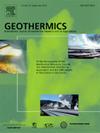Heat flow and thermal structure of the East China Sea
IF 3.5
2区 工程技术
Q3 ENERGY & FUELS
引用次数: 0
Abstract
Heat flow and thermal structure are crucial for understanding the tectonic evolution and geodynamics of marginal seas. The East China Sea (ECS) occupies a unique position within the West Pacific marginal seas system, characterized by the existence of the actively spreading Okinawa Trough-a back-arc basin in its early evolutionary stage. However, the thermal regime of the ECS remains poorly constrained, due to limited data coverage and variable data quality in previous compilations. Here we report some additional new heat flow data, and integrate all the geothermal data available from the ECS with thermal modeling, to depict the heat flow pattern of the ECS and thermal structure of the lithosphere there. The results show that the ECS is of typical heat flow pattern for the trench-arc-basin system. Amongst, the East China Sea continental shelf exhibits a moderate heat flow (<65 mW/m2), while the Okinawa Trough shows high heat flow with a large variability (>100 mW/m2, except those extremely high values affected by fluid activities), and the heat flow for the Ryukyu Trench is quite lower (∼50 mW/m2). In contrast to the central and southern segments, the northern segment of the Okinawa Trough has a weaker crustal extension, resulting in a small geothermal gradient and a large lithospheric thickness. The thermal regime of the East China Sea is generally controlled by subduction process, but such environmental factors as magmatism and fluid circulation also contribute to local heat flow anomalies. For instance, the heat flow pattern of the Okinawa Trough is significantly influenced by strong fluid activities and magmatism, with the coexistence of high and low heat flow in the central and southern segments. The findings could not only provide a good example for exploring the relationship between heat flow and regional tectonics, but also is significant for hydrocarbon potential assessment in the East China Sea.
东海热流与热结构
热流和热结构是认识边缘海构造演化和地球动力学的关键。东海在西太平洋边缘海体系中占有独特的位置,其早期演化阶段存在活跃扩张的冲绳海槽——弧后盆地。然而,由于以前的汇编中数据覆盖范围有限和数据质量可变,ECS的热状态仍然受到很差的约束。在此,我们报告了一些新的热流数据,并将所有可获得的ECS地热数据与热模拟相结合,以描述ECS的热流模式和岩石圈的热结构。研究结果表明,东中国海具有典型的海沟-弧-盆地系统热流模式。其中,东海大陆架热流表现为中等热流(约65 mW/m2),冲绳海槽热流表现为高热流,但变动性大(约100 mW/m2,但受流体活动影响的数值极高),琉球海沟热流较低(约50 mW/m2)。与冲绳海槽中部和南部相比,冲绳海槽北段地壳伸展较弱,地温梯度较小,岩石圈厚度较大。东海的热状态总体上受俯冲过程控制,但岩浆活动和流体循环等环境因素也会导致局部热流异常。例如,冲绳海槽的热流形态受强流体活动和岩浆活动的显著影响,在中部和南部段存在高热流和低热流并存。这一发现不仅为探索东海热流与区域构造的关系提供了良好的范例,而且对东海油气潜力评价具有重要意义。
本文章由计算机程序翻译,如有差异,请以英文原文为准。
求助全文
约1分钟内获得全文
求助全文
来源期刊

Geothermics
工程技术-地球科学综合
CiteScore
7.70
自引率
15.40%
发文量
237
审稿时长
4.5 months
期刊介绍:
Geothermics is an international journal devoted to the research and development of geothermal energy. The International Board of Editors of Geothermics, which comprises specialists in the various aspects of geothermal resources, exploration and development, guarantees the balanced, comprehensive view of scientific and technological developments in this promising energy field.
It promulgates the state of the art and science of geothermal energy, its exploration and exploitation through a regular exchange of information from all parts of the world. The journal publishes articles dealing with the theory, exploration techniques and all aspects of the utilization of geothermal resources. Geothermics serves as the scientific house, or exchange medium, through which the growing community of geothermal specialists can provide and receive information.
 求助内容:
求助内容: 应助结果提醒方式:
应助结果提醒方式:


